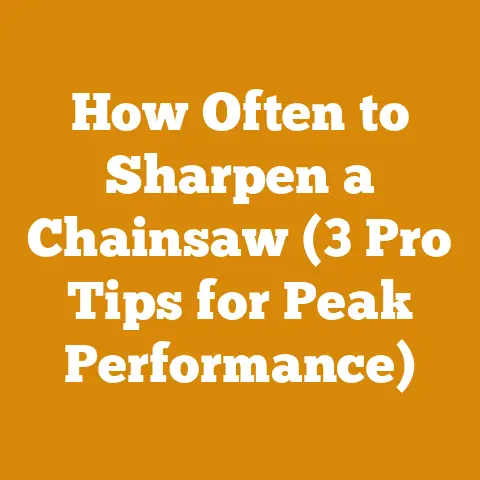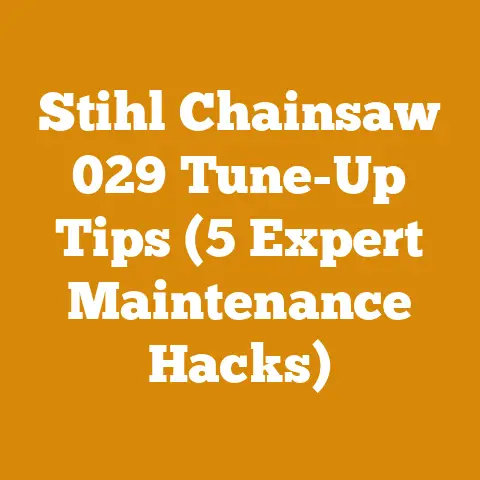Flexible Rods Chimney Cleaning (Pro Tips for Safe Wood Stove Care)
Flexible Rods Chimney Cleaning: Pro Tips for Safe Wood Stove Care
My journey into chimney cleaning wasn’t just about avoiding disaster; it was also about saving money and gaining independence. I was tired of relying on expensive chimney sweeps and their unpredictable schedules. Learning to do it myself, safely and effectively, felt empowering. But before you dive in, let’s address the elephant in the room: safety.
The Chimney Fire Dilemma: Why Cleaning Matters
Chimney fires are a serious threat. Creosote, a highly flammable byproduct of burning wood, builds up in your chimney over time. Even a thin layer can ignite, sending flames and sparks shooting out of your chimney and potentially into your home. According to the National Fire Protection Association (NFPA), heating equipment is a leading cause of home fires, and a significant portion of those fires are chimney-related.
- NFPA Statistics: Heating equipment is the second leading cause of home fires in the U.S.
- Creosote Accumulation: As little as 1/8 inch of creosote buildup is enough to fuel a chimney fire.
- Cost of Neglect: Chimney fires can cause significant property damage and even loss of life.
I remember reading a local news story about a house fire caused by a neglected chimney. The damage was extensive, and the family was displaced. That story really drove home the importance of regular chimney cleaning.
Understanding Flexible Rods: Your Chimney Cleaning Arsenal
Flexible chimney cleaning rods are designed to navigate the bends and curves of your chimney flue. They’re typically made of durable materials like polypropylene or nylon and come in various lengths and diameters. The key to success is choosing the right rods for your specific chimney.
- Material Matters: Polypropylene rods are more rigid and suitable for straight flues, while nylon rods are more flexible and better for chimneys with multiple bends.
- Diameter Dilemma: Choose a rod diameter that matches the size of your chimney flue. Too small, and you won’t clean effectively; too large, and you’ll struggle to maneuver.
- Length is Key: Make sure you have enough rods to reach the entire length of your chimney. It’s always better to have a little extra than to come up short.
When I first started, I bought a cheap set of rods from a big box store. They were flimsy and difficult to use, and I quickly realized that investing in quality equipment was essential.
Choosing the Right Brush: A Matter of Matching
The brush you use with your flexible rods is just as important as the rods themselves. The brush needs to be the correct size and shape for your chimney flue, and it needs to be made of a material that won’t damage the chimney liner.
- Round vs. Square: Round brushes are suitable for round flues, while square brushes are better for square or rectangular flues.
- Wire vs. Poly: Wire brushes are more aggressive and effective at removing heavy creosote buildup, but they can damage metal chimney liners. Poly brushes are gentler and safer for metal liners.
- Size Matters (Again!): The brush should be slightly larger than the diameter of your flue to ensure effective cleaning.
I learned the hard way about using the wrong brush. I used a wire brush on my stainless steel liner, and it left scratches that could potentially weaken the liner over time. Now, I only use a poly brush.
Safety First: Gearing Up for Success
Before you even think about inserting a rod into your chimney, you need to prioritize safety. This means wearing the right protective gear and taking precautions to protect your home and yourself.
- Eye Protection: Wear safety glasses or goggles to protect your eyes from falling debris.
- Respiratory Protection: Wear a dust mask or respirator to avoid inhaling soot and creosote particles.
- Hand Protection: Wear gloves to protect your hands from sharp edges and abrasive materials.
- Drop Cloths: Cover your fireplace opening and surrounding area with drop cloths to protect your floors and furniture.
- Ladder Safety: If you’re cleaning from the roof, use a sturdy ladder and have someone spot you.
I always wear a full-face respirator when cleaning my chimney. It might seem like overkill, but I’d rather be safe than sorry.
The Cleaning Process: A Step-by-Step Guide
Now that you have the right equipment and safety gear, it’s time to get down to business. Here’s a step-by-step guide to cleaning your chimney with flexible rods:
- Prepare the Area: Cover your fireplace opening and surrounding area with drop cloths.
- Assemble the Rods: Connect the first rod to the brush.
- Insert the Rod: Carefully insert the brush and rod into the chimney flue, either from the bottom (fireplace) or the top (chimney cap).
- Push and Rotate: Push the rod up (or down) the flue, rotating it as you go. This will help to loosen and remove creosote buildup.
- Add More Rods: As you reach further into the flue, add more rods to the end of the existing ones.
- Clean the Entire Flue: Continue pushing and rotating the brush until you’ve cleaned the entire length of the flue.
- Remove the Rods: Carefully remove the rods, one at a time, as you pull the brush back down (or up) the flue.
- Clean Up: Remove the drop cloths and dispose of the collected soot and creosote.
- Inspect: Inspect the chimney flue for any damage or excessive creosote buildup.
I find that using a slow, steady motion is the most effective way to clean the chimney. Rushing the process can lead to missed spots and incomplete cleaning.
Mastering the Technique: Tips and Tricks
Cleaning a chimney with flexible rods is a skill that improves with practice. Here are a few tips and tricks I’ve learned over the years:
- Start with a Clean Chimney: If your chimney has a lot of creosote buildup, it may be helpful to have it professionally cleaned before you start using flexible rods. This will make the process easier and more effective.
- Use a Chimney Camera: A chimney camera can help you to inspect the flue and identify areas that need extra attention.
- Clean Regularly: The more often you clean your chimney, the less creosote will build up, and the easier the cleaning process will be. I try to clean mine at least twice a year, once in the spring and once in the fall.
- Listen to Your Chimney: Pay attention to how your chimney sounds when you’re burning wood. A roaring sound can indicate a chimney fire.
- Adjust Your Burning Habits: Burning seasoned wood and maintaining a hot fire can help to reduce creosote buildup.
I once used a chimney camera to find a bird’s nest blocking my flue. It was a good thing I caught it before I started a fire!
The Cost Breakdown: DIY vs. Professional Cleaning
One of the biggest reasons I started cleaning my chimney myself was to save money. But is it really cheaper to do it yourself? Let’s break down the costs:
DIY Chimney Cleaning:
- Flexible Rods and Brush: \$50 – \$200 (one-time investment)
- Safety Gear: \$20 – \$50 (one-time investment)
- Time: 2-4 hours per cleaning
- Total Cost: \$70 – \$250 (initial investment) + minimal recurring costs (replacement brushes, etc.)
Professional Chimney Cleaning:
- Cost per Cleaning: \$150 – \$300
- Frequency: Recommended annually
- Total Cost: \$150 – \$300 per year
As you can see, the initial investment for DIY chimney cleaning is higher, but over time, it can save you a significant amount of money. Plus, you have the added benefit of being able to clean your chimney whenever you need to, without having to wait for a professional.
Cost Factors to Consider:
- Chimney Height and Complexity: Taller and more complex chimneys will require more expensive and specialized equipment.
- Creosote Buildup: Heavily creosote-laden chimneys may require more aggressive cleaning methods, potentially increasing the cost of professional cleaning.
- Location: Labor costs for professional chimney sweeps can vary depending on your location.
I found that after cleaning my chimney myself for a few years, I had more than recouped the initial investment in equipment. And the peace of mind knowing that my chimney is clean and safe is priceless.
Case Study: My DIY Chimney Cleaning Budget
Let’s take a closer look at my personal chimney cleaning budget:
- Flexible Rods (30 ft., Nylon): \$80
- Poly Brush (8-inch Round): \$30
- Full-Face Respirator: \$40
- Safety Glasses: \$10
- Gloves: \$5
- Drop Cloths: \$15
- Total Initial Investment: \$180
Based on a professional cleaning cost of \$200 per year, I broke even in less than a year. And now, I’m saving \$200 every year by cleaning my chimney myself.
Optimizing Your Chimney Cleaning Budget: Smart Choices
Here are a few tips for optimizing your chimney cleaning budget:
- Buy Quality Equipment: Don’t skimp on quality. Invest in durable rods and brushes that will last for years.
- Shop Around: Compare prices from different retailers before making a purchase.
- Consider a Chimney Camera: While not essential, a chimney camera can help you to identify problem areas and avoid unnecessary cleanings.
- Maintain Your Equipment: Clean your rods and brushes after each use to prolong their lifespan.
- Clean Regularly: Regular cleaning prevents heavy creosote buildup, making the cleaning process easier and potentially reducing the need for expensive professional cleanings.
I’ve found that buying equipment online can often save you money compared to buying from a local hardware store.
Legal and Regulatory Considerations
Before you start cleaning your chimney, it’s important to be aware of any local laws or regulations that may apply. Some municipalities require homeowners to have their chimneys inspected by a certified professional on a regular basis. Others may have specific requirements for the disposal of soot and creosote.
- Local Codes: Check with your local building department or fire marshal for information on chimney cleaning regulations.
- Insurance Requirements: Some insurance companies may require proof of regular chimney cleaning to maintain coverage.
- Disposal Guidelines: Follow local guidelines for the disposal of soot and creosote.
I always check with my local building department before starting any home improvement project, including chimney cleaning.
Troubleshooting Common Issues
Even with the best equipment and preparation, you may encounter some challenges when cleaning your chimney. Here are a few common issues and how to troubleshoot them:
- Rods Getting Stuck: If your rods get stuck in the flue, try rotating them back and forth to loosen them. You may also need to use a smaller diameter brush.
- Excessive Creosote Buildup: If your chimney has a lot of creosote buildup, it may be helpful to use a chemical creosote remover before cleaning with flexible rods.
- Damaged Chimney Liner: If you notice any damage to your chimney liner, such as cracks or missing pieces, have it inspected by a professional before using your wood stove.
- Difficulty Reaching the Top: If you’re having trouble reaching the top of your chimney, you may need to use a longer set of rods or consider cleaning from the roof.
I once had my rods get stuck in a particularly narrow section of my flue. It took me a while to wiggle them free, but I eventually managed to do it without damaging the rods or the chimney.
Beyond the Basics: Advanced Chimney Care
Once you’ve mastered the basics of chimney cleaning, you may want to explore some advanced techniques and tools.
- Chimney Caps: Install a chimney cap to prevent rain, snow, and animals from entering your chimney.
- Chimney Liners: Consider installing a stainless steel chimney liner to protect your chimney from damage and improve its efficiency.
- Draft Optimization: Optimize your chimney draft by adjusting the damper and using a chimney thermometer.
I installed a chimney cap a few years ago, and it’s made a big difference in keeping my chimney clean and dry.
The Environmental Impact: Responsible Wood Burning
As wood burners, we have a responsibility to minimize our environmental impact. This means burning seasoned wood, maintaining a hot fire, and cleaning our chimneys regularly.
- Seasoned Wood: Burning seasoned wood reduces emissions and creosote buildup.
- Efficient Stoves: Use an EPA-certified wood stove for cleaner burning.
- Responsible Disposal: Dispose of ashes and soot properly.
I always make sure to buy my firewood from a reputable supplier who sells seasoned wood.
The Future of Chimney Cleaning: Technology and Innovation
The world of chimney cleaning is constantly evolving, with new technologies and innovations emerging all the time. From robotic chimney cleaners to advanced creosote removal products, the future of chimney cleaning is looking bright.
- Robotic Cleaners: Robotic chimney cleaners offer a hands-free cleaning solution.
- Advanced Products: New creosote removal products are more effective and environmentally friendly.
- Smart Monitoring: Smart chimney monitoring systems can alert you to potential problems before they become serious.
I’m excited to see what the future holds for chimney cleaning technology.
Actionable Takeaways: Your Next Steps
So, what are your next steps? Here’s a summary of the key takeaways from this guide:
- Assess Your Needs: Determine the type of chimney you have and the equipment you need.
- Prioritize Safety: Invest in safety gear and follow safe cleaning practices.
- Clean Regularly: Clean your chimney at least once a year, or more often if needed.
- Monitor Your Chimney: Pay attention to how your chimney sounds and looks, and address any problems promptly.
- Stay Informed: Keep up to date on the latest chimney cleaning techniques and technologies.
Cleaning your chimney with flexible rods is a rewarding and cost-effective way to keep your home safe and warm. By following the tips and techniques in this guide, you can become a confident and capable chimney cleaner.
A Final Word: Peace of Mind
For me, cleaning my own chimney isn’t just about saving money or avoiding professional fees. It’s about peace of mind. Knowing that I’ve taken the necessary steps to keep my home and family safe from the dangers of chimney fires is worth more than any amount of money. So, grab your flexible rods, put on your safety gear, and get cleaning! You’ll be glad you did. And remember, a clean chimney is a happy chimney, and a happy chimney means a safe and warm home for you and your loved ones. This journey into DIY chimney cleaning has not only saved me money but also provided me with a deeper understanding of my wood stove and the importance of responsible wood burning. Now, I can enjoy the warmth of my fire with confidence, knowing that I’ve done my part to keep my home safe.






